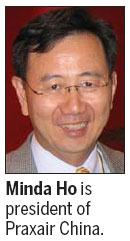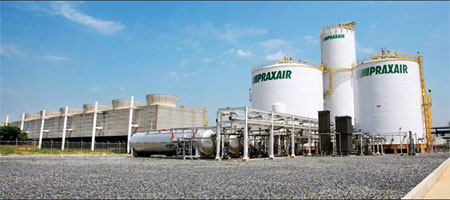Gassed up and good to go
Updated: 2012-10-26 09:40
By Zhong Nan (China Daily)
|
||||||||
|
An air separation plant of Praxair China in Zhenjiang, Jiangsu province, supplies customers in the chemical industry. Provided to China Daily |

Praxair to capitalize on China's industrial focus
Praxair Inc, the largest industrial-gases producer by market share in North and South America and one of the largest worldwide, is further driving the growth of its business in China's gasification, clean fuel and environment sectors as the nation's push to upgrade its industrial sector ensures constant demand for various gases.
For many years, China's inexpensive resources have assisted the boom of its manufacturing sector, which has had the unfortunate side effects of low profit, heavy pollution and increased energy consumption. Also, the economic mess in the US and Europe has not only cut down the purchasing power of developed countries, but also led to a structural conflict between insufficient global demand and oversupply.
To change this situation, China has been trying hard to reduce its heavy dependence on the export of simple and cheap products such as textiles, garments and toys. China is transforming its industrial development from a labor-intensive model to one focused on high-end and clean-energy-related industries during the period of the nation's 12th Five-Year Plan (2011-15).
High-end and clean-energy industries - such as advanced coal gasification, chemicals, machineries, energy efficiency, emissions control and water treatment - are among the nation's top development priorities. Industrial gases and related technologies are indispensable to these segments.
Minda Ho, president of Praxair China and global vice-president of gasification at Praxair Inc, says China still has much room to develop high-end industries. The company is working on a large air separation plant project in South China's Guangdong province, which will be the largest project in Praxair China's history.
Praxair began its China endeavor in 1988 and established its first joint venture in 1992 in Beijing. With more than 1,400 employees across the country, Praxair currently operates 22 wholly owned companies and 10 joint ventures in China.
The company supplies atmospheric, process and specialty gases, high-performance coatings and related services and technologies to a wide range of customers from sectors including aerospace, chemicals, food and beverage, electronics, energy, healthcare, manufacturing, metals and others.
Analysts have pointed out that China's demand for industrial gases will surge in the next decade. The China Industrial Gas Association predicted that China's demand for industrial gases could hit 100 billion yuan ($15.94 billion; 12.35 billion euros) in 2016. The nation consumed 70 billion yuan of industrial gases last year.
To further enhance its presence in the Chinese market, in June Praxair signed a long-term supply contract with Yankuang Guohong Chemical Co Ltd and Yankuang Group, a coal-based chemical and gasification technology enterprise.
The contract will see Praxair supply industrial gases used in the coal gasification process at Yankuang Guohong's chemical park in Zoucheng, Shandong province. To meet these gas requirements, Praxair is now constructing a large-scale air separation facility with a capacity of 3,000 tons of oxygen per day.
This will be the fourth facility with a capacity of 3,000 tons per day or greater that Praxair has established in China. Two of its other plants are operating in Zhenjiang, Jiangsu province, and Wuwei, Anhui province, to supply customers in the coal-based chemical industry.
Ho says China has a huge territory with regions in different stages of development. Apart from the coastal regions that already enjoy affluence and rapidly developed industries, there are still large inland areas where the pace of growth needs to catch up.
"The Chinese government made the wise decision to invest in infrastructure building and developing the western regions, which demands huge volumes of construction material like iron and steel, as well as heavy equipment that requires large volumes of industrial gases during the production process," Ho says.
Praxair formed a joint venture with Chongqing Chemical and Pharmaceutical Holding (Group) Company last year to supply the oxygen, nitrogen and clean dry air to a major integrated chemical production complex in Chongqing Changshou Chemical Industrial Park, a new inland economic zone in the industrial capital of western China.
The collaboration will see Praxair build and operate two air separation units with a total daily capacity of 5,000 tons of gaseous oxygen.
The new facility will supply a large-scale integrated chemical production complex anchored by a BASF (China) methylene diphenyl diisocyanate (MDI) production plant, which is widely used in the manufacture of polyurethane for plastics and insulation for refrigeration and buildings.
It also will provide liquid oxygen, nitrogen and argon to the region's rapidly growing merchant market. The project is under way and start-up is scheduled for the first half of 2014.
"In comparison with the US and European markets, the Chinese market is more diversified in terms of styles of doing business and industrial development. Usually you need to spend more time getting to know and building rapport with a customer here. In many cases it is essential to establish a relationship before conducting business," Ho says.
"Our marketing strategy in China includes building density in core markets, expanding geographic coverage and a rigorous selective approach for quality customers."
In 2011, Praxair's combined sales revenue in China exceeded $600 million (465 million euros), about 5 percent of its $11 billion global sales last year. The company is currently partnering with a number of Chinese petroleum and chemical enterprises as well as large steel mills, on air separation unit cooperation projects, including Sinopec Group, China National Petroleum Corp, China National Offshore Oil Corp and Baoshan Iron & Steel Co Ltd.
Ho says it is also important to optimize its distribution networks in China, as the size of distribution fleets is linked to actual industrial gas production and sales volumes.
"We will consistently ensure the safety, reliability and efficiency of our distribution network when supporting the ramp-up of future business. We expect a double-digit growth in China this year," Ho says.
Li Qunsheng, a professor of chemical engineering at Beijing University of Chemical Technology, says demand for industrial gases will continue to surge over the next decade due to the rapid development of China's coal, chemical, petrochemical, metallurgy, medical, food, auto and environmental industries.
"China's stable market growth to a certain degree has sped up the expansion of giant foreign gas makers such as the US' Praxair, Air Products and Chemicals Inc and France's Air Liquide SA in China," Li says, "because they have sophisticated technologies in producing high quality gases and setting long-term product targets for energy, water and chemical use."
Even though Chinese gas makers outnumber international players in the domestic market, Chinese companies still cannot compete as they are incapable of making high-capacity air separation units. Air separation units with a capacity of 3,000 tons per day or more all require the import of key components and technological know-how.
"The challenges I view for developing business in China are the continual productivity improvement to overcome cost escalation from all sides - power, fuel and labor; recruiting, developing and retaining qualified talents to support the business growth; and building superior business culture," Ho says.
zhongnan@chinadaily.com.cn
(China Daily 10/26/2012 page16)

 Relief reaches isolated village
Relief reaches isolated village
 Rainfall poses new threats to quake-hit region
Rainfall poses new threats to quake-hit region
 Funerals begin for Boston bombing victims
Funerals begin for Boston bombing victims
 Quake takeaway from China's Air Force
Quake takeaway from China's Air Force
 Obama celebrates young inventors at science fair
Obama celebrates young inventors at science fair
 Earth Day marked around the world
Earth Day marked around the world
 Volunteer team helping students find sense of normalcy
Volunteer team helping students find sense of normalcy
 Ethnic groups quick to join rescue efforts
Ethnic groups quick to join rescue efforts
Most Viewed
Editor's Picks

|

|

|

|

|

|
Today's Top News
Chinese fleet drives out Japan's boats from Diaoyu
Health new priority for quake zone
Inspired by Guan, more Chinese pick up golf
Russia criticizes US reports on human rights
China, ROK criticize visits to shrine
Sino-US shared interests emphasized
China 'aims to share its dream with world'
Chinese president appoints 5 new ambassadors
US Weekly

|

|







